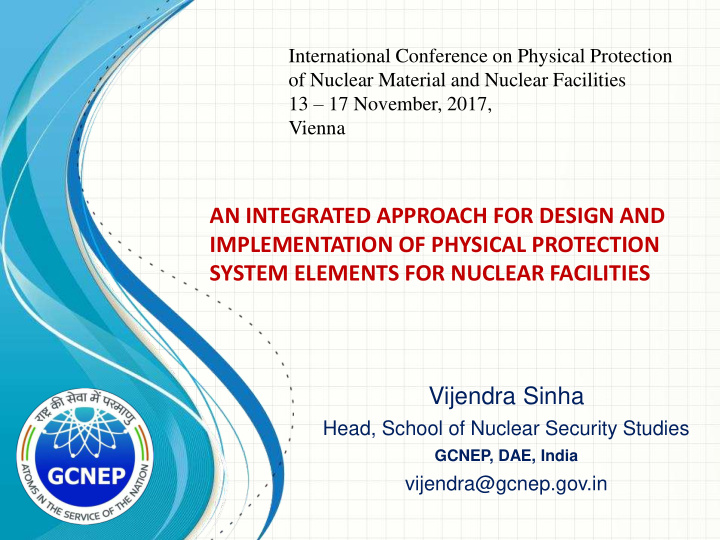



International Conference on Physical Protection of Nuclear Material and Nuclear Facilities 13 – 17 November, 2017, Vienna AN INTEGRATED APPROACH FOR DESIGN AND IMPLEMENTATION OF PHYSICAL PROTECTION SYSTEM ELEMENTS FOR NUCLEAR FACILITIES Vijendra Sinha Head, School of Nuclear Security Studies GCNEP, DAE, India vijendra@gcnep.gov.in
Introduction Nuclear Facilities (NF) NF handles different process stages NF by design are distributed in nature Processes and systems in a NF are geographically & logically distributed Physical Protection System (PPS) PPS aims to prevent theft of NM, sabotage at NF Conventional PPS are independent & limited in information and resource sharing Integrated PPS In modern approach, PPS across various geographically separated sub- systems are integrated to provide the system functionality Common Operating Picture & Informed decision making 2
• Prevent theft of nuclear material and other radioactive material Nuclear Weapon Nuclear Material Radioactive Dispersal Device Radioactive Material • Prevent sabotage of NF resulting in radiological release
Physical Protection System (PPS) Physical Protection System involves Integration of People, Procedures & Equipments, spread across a NF People Procedure Equipment • People: Need and Role based involvement is factored into the PPS for Integrated approach • Procedure: SOP and its Interface with Process • Equipment: Integration of PPS equipment (sensors, controls, barriers etc.) 4
PPS Functions Protection Prevention Reaction (Detection & Analysis) (Delay) (Response) • Intrusion Sensing Guards & Response Forces • Passive Barriers • Interruption: • Alarm Communication • Active Barriers • Communication • Alarm Assessment • Entry Control • Deployment • Contraband Detection • Neutralization Technology / Procedures / professional security staff
PPS Design Considerations • Design of PPS needs Assessment at various Levels – Stakeholder related – Process related – PPS domain related • Selection of PPS elements for NF is driven by – Facility Characterization – Threat Definition – Target Identification 6
PPS Desirable Features Diversity Redundancy Confidentiality (Encryption) Balanced Protection Protection-in-Depth Graded Approach 7
CCTV DFMD Turnstile Electronic means increases the effectiveness of the Security as well as efficiency of the man in the loop. Tripod
Radioactive Material Detection - Boarders - Sea ports - Air ports Personal Detectors
Tyre killer Boom Barrier Bollards Road Blocker
5 mm Resolution 100 mm Steel Penetration Cargo Monitoring Container Scanning
Integrated PPS Approach 12
Hypothetical Nuclear Facility (HNF) To evolve an integrated approach to PPS design & implementation, a Hypothetical Nuclear Facility (HNF) is considered. A facility of approx. dimension- 400m x 300m Reconfigurable Facility for training and education purpose Facilities Located in HNF: Reactor Building, Control Room, Auxiliary Control Room, Turbine Building, Spent Fuel Bay, Waste Management Facility, and Isotope Lab besides Central Alarm Station & Secondary Alarm Station. HNF is equipped with integrated PPS 13
HNF Layout 14
HNF – PPS Details (1/2) The various PPS elements considered at HNF include: Perimeter Intrusion Detection System (PIDS) • Active IR sensors at double fence area. • 8 No of E-Fence Zones with communication controller at outer fence of double fence area. Access Control System (ACS) • 8 Nos. of RFID based readers with controllers & full height turnstile gates for access control), metal detector and a baggage scanner system at Personal Entry Portal (PEP). • 10 Nos. of Biometric and RFID based readers with full height turnstile gate at various Inner & Vital area. • 20 Door Monitoring Systems – normal & emergency doors. • Boom Barrier, Bollard, Road Blocker & Tyre Killer at Vehicle Entry Portal (VEP). 15
HNF – PPS Details (2/2) The various PPS elements considered at HNF include: Intrusion Detection System (IDS) • 32 Nos. of Micro Wave based IDS sensors at Inner area, Vital Area, PEP, VEP and CAS. • 16 Nos. of Passive IR sensors at Inner Area, Vital Area, PEP, VEP and CAS. CCTV Surveillance e System: • 6 Nos. of Pan-Tilt-Zoom cameras at exclusion zone boundary. • 24 Nos. of fixed bullet type camera for alarm assessment at double fence zone area. • 20 Nos. of fixed dome type camera at PEP, VEP and CAS. • 30 Nos. of fixed dome type camera at inner and vital area. 16
HNF- Integrated PPS 17
Typical IPPS An Integrated Physical Protection System (IPPS) is in place at all Nuclear Installations and is a Pre-Requisite for new builds.
Integrated Networked System (PPS) Dual redundant network bus
Common Operating Picture (COP) Central Alarm Station Perimeter Intrusion Detection System CCTV ASSESSMENT ACCESS CONTROL Interior Intrusion Detection System Vehicle Access Control Material Access Control Secondary Alarm Station 20
Advantage of Integrated PPS Approach Enhanced site supervision and an improved probability of detection Centralized video & surveillance management system driving the COP Reconfigurable automated interaction within the PPS elements Centralized and graded access control policies for visitors, staff and vehicles Better understanding & accreditation of systems Centralized vehicle and person screening Better management of false and nuisance alarms Centralized incident and response management Better managed coordination for event management and disaster recovery Centralized platform to carry out scenario based simulation studies Efficiently introducing redundancy and diversity 21
Conclu nclusion sion Integrated Physical Protection System is gaining importance as it addresses • complex and dynamic changes in security scenario. Integrated PPS provides – • Common Operating Picture for effective & efficient security • Informed decision making • Centralized data repository for PPS elements • Better understanding of the systems & sub-systems • During the risk and threat assessment phases of developing an IPPS, you frequently discover areas of vulnerability that can be remedied and practices that can be improved. Easy to use, easy to scale, quick to analysis and easy to reconfigure systems to • fit the desired responses. All People & Nuclear Facility needs to be safe and secure .
Recommend
More recommend